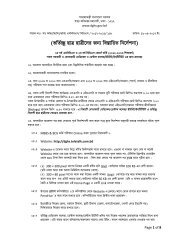Health Bulletin 2009
Health Bulletin 2009
Health Bulletin 2009
Create successful ePaper yourself
Turn your PDF publications into a flip-book with our unique Google optimized e-Paper software.
increasess sharply with the age of the children. Children in the urban areas<br />
and children of<br />
mothers who have completed primary education or higher are more<br />
likely to be fed according to<br />
IYCF recommendation. Feeding<br />
practices in the Rajshahi, Khulna, and Dhakaa are better than<br />
other divisions.<br />
120%<br />
Infant and Young Child Feeding<br />
(IYCF) Practices<br />
100%<br />
80%<br />
57%<br />
58%<br />
60%<br />
89%<br />
40%<br />
20%<br />
43%<br />
42%<br />
0%<br />
11%<br />
Breasted<br />
Non breastfed All 6‐23<br />
months<br />
Fed with all 3 IYCF practices<br />
Non fed with all 3 IYCF practices<br />
Strengthening laboratory activities<br />
The purpose of this activity is to develop the effective laboratory facilities of food and<br />
biochemical aspects of nutrition and to introduce serological tests for nutrition related diseases.<br />
IPHN is running its child nutritionn units (CNUs) to full strength. All laboratory tests for identifying<br />
nutritional status of children and<br />
mothers are routinely done at IPHN laboratory. Iodine content<br />
of salt is also routinely tested.<br />
Nutrition<br />
survey<br />
To assess the nutritional situation surveys are now being carried out in selected districts. The<br />
survey will find answers to questions like impact of price hike on household food security, food<br />
quality and nutritional status of poor women and children in Bangladesh. A survey was done<br />
among 164 families in Bangalipoor union of Saidpur upazila under Nilphamari district.<br />
Child Nutrition Unit<br />
(CNU)<br />
The Institute of Public <strong>Health</strong> Nutrition is running 20 Child Nutrition<br />
Units, one located at IPHN<br />
and the others in 19<br />
upazila health complexes in each of the greater 19 districts. The program<br />
has provided one nutritionist and<br />
a lady visitor to each center. The overall aim is to improve the<br />
nutritional status of the under- 5 children and mothers of the country. The CNUs provides<br />
services like growth monitoring;<br />
supplementation; complementary<br />
feeding; nutrition corner for<br />
mothers' education on nutrition; breast feeding corner; treatment of malnutrition<br />
and associated problem; referral<br />
center; and<br />
demonstration of home<br />
gardening. IPHN has taken<br />
steps to revitalize and provide more functional supports to CNUs.<br />
National<br />
Rickets Survey , 2008<br />
Rickets is<br />
a disease of children in which growing bones<br />
fail to calcify properly and becomee bent<br />
by the weight of the body and the pull of muscles. Rickets is most common due to a deficiency<br />
of vitamin<br />
D, an essential micronutrient obtained either from the diet or made in the body when<br />
the skin is exposed to sunlight. As vitamin D can be made in the skin, it is uncommon in the<br />
tropical or subtropical countries. When rickets does occur in sunny countries, it is usually due to<br />
other causes, such as calcium deficiency. Vitamin D deficiency<br />
rickets tends to be seen in very<br />
young children who have a soft and enlarged skull, swollen<br />
wrists and ankles and are prone<br />
to respiratory infections. In four different surveys conducted by<br />
the Institute of Child and Mother <strong>Health</strong><br />
(ICMH), 1998; Bangladesh Rural Advancement<br />
52


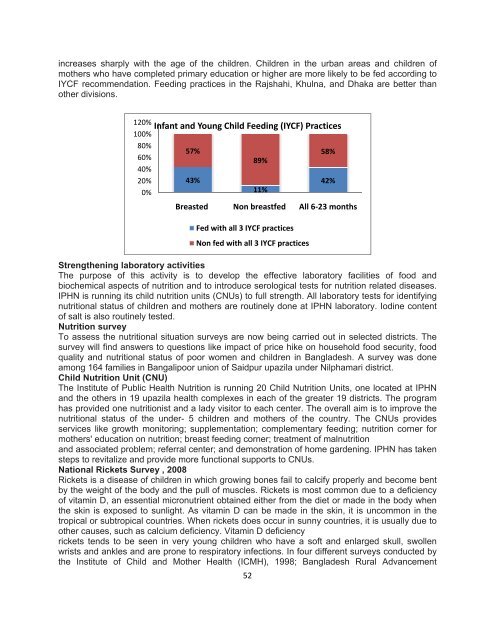
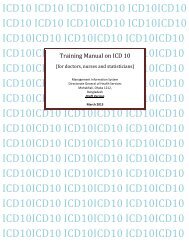




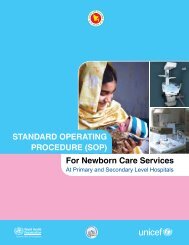
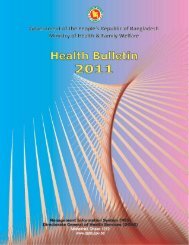
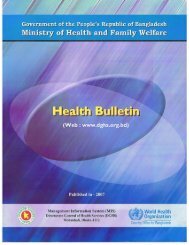
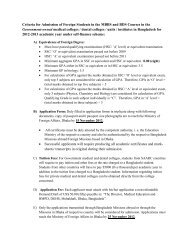
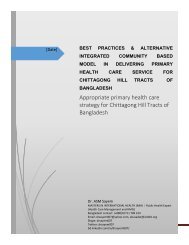
![Bangladesh Demographic and Health Survey 2007 [FR207]](https://img.yumpu.com/38440445/1/190x257/bangladesh-demographic-and-health-survey-2007-fr207.jpg?quality=85)
